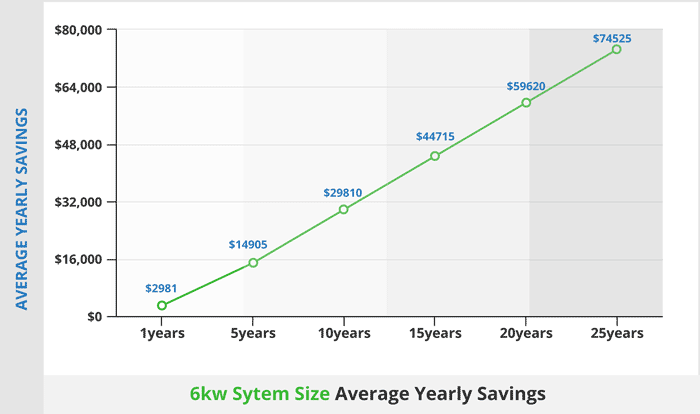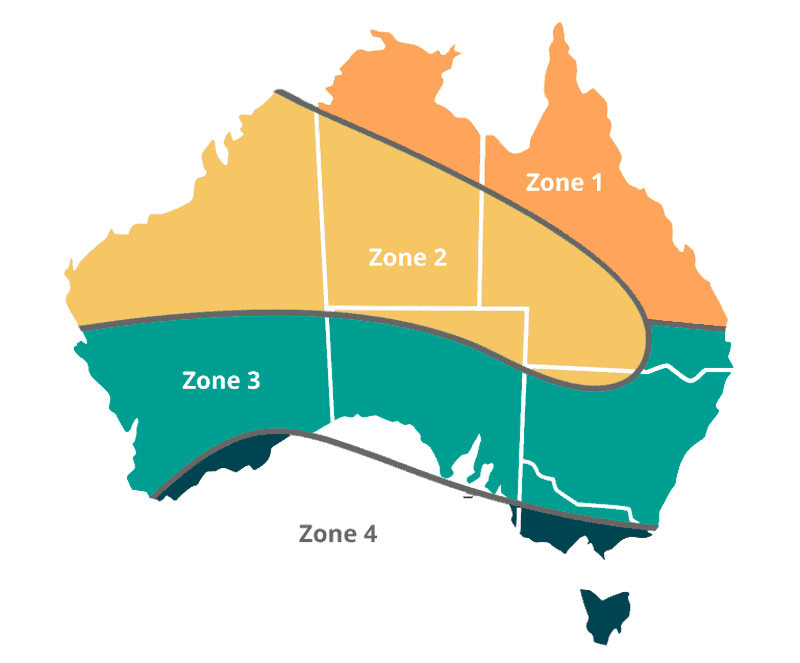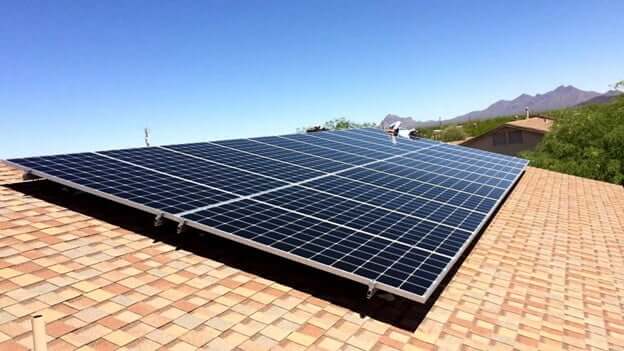Home Cost 6.6kW Solar System Cost
6.6kW Solar System Cost
In 2024, there’s a noticeable uptick in the selection of 6.6 kW solar systems across Australia [1], largely due to their affordability, suitability for the typical Aussie home, and significant rebates offered by the government.
On average, a 6.6 kW solar system costs around $7,500 – $9,500 before any Small-Scale Technology Tokens (STCs) have been deducted2. However, generally, typical pre-rebate cost of an installed 6.6kW solar system is $9,140 with an addition of Government Rebate of $2,590. Hence, total cost to any customer for 6.6kW of solar power is Approx $6,550 [3].
Different brands, solar panel quality, and installers play a role in solar panel prices. The state you live in and the amount of rebate you are eligible for also play a factor.
| 6.6kW Solar System | Price |
|---|---|
| National Average | $7,322 |
| Low Estimate | $6,978 |
| High Estimate | $7,764 |
Table of Contents
Toggle6.6 kW Solar System Price by State
| State | 6.6kW Price |
|---|---|
| New South Wales | $7,410 |
| Victoria | $7,764 |
| Queensland | $6,978 |
| Canberra ACT | $7,410 |
| South Australia | $7,410 |
| Western Australia | $7,410 |
| National Average | $7,322 |
How much will a 6.6 kW solar system save me?
On average, a good-quality 6.6 kW solar system can save you between $1,200 and $2,000 or more a year on your power bills [4]. This will, however, depend on your power consumption habits and your location.
Below is a simple illustration of how much money a 6.6 kW solar system can save you over its lifetime (25 years).

How many panels are needed for a 6.6 kW solar power system?
A typical 6.6 kW solar system will require 18 x 370 W solar panels, each measuring 1 m by 1.7 m [5].
However, panel size and the number of panels may vary from manufacturer to manufacturer. Some manufacturers do manage to make solar panels with higher outputs and therefore need fewer panels for a given output rating. You will need to check your north-facing roof space to see which option is best for you.
Here are some common solar panel sizes that can make up a 6.6 kW solar system [5]:
- 330W (20 x solar panels to make 6.60kW)
- 350W (19 x solar panels to make 6.65kW)
- 370W (18 x solar panels to make 6.66kW)
- 390W (17 x solar panels to make 6.63kW)
- 400W (17 x solar panels to make 6.80kW)
- 420W (16 x solar panels to make 6.72kW)
- 450W (15 x solar panels to make 6.75kW)
- 480W (14 x solar panels to make 6.72kW)
- 500W (13 x solar panels to make 6.50kW)
How much roof space does a 6.6 kW solar system need?
A 6.6 kW solar power system using 370 W solar panels measuring 1.75 m x 1 m will require about 31.5 m2 of roof space [6].
If you use larger panels, the amount of roof space required for your installation will be less.
Calculations:
1.75 m x 18 (370 W) panels = 31.5 m2 of roof space
1.75 m x 13 (500 W) panels = 22.8 m2 of roof space
Solar rebate for a 6.6 kW solar power system
A 6.6 kW solar system receives a rebate of about $2,476, but the exact amount will depend on the state you live in. Different states are in different STC zones, which allow different rebate amounts.
Zones: 1, 2, 3
States: NSW, QLD, WA, SA, NT, ACT
STC’s: 63
Rebate: $2,476
Zones: 4
States: VIC, TAS
STC’s: 54
Rebate: $2,122

How do I know if the 6.6 kW solar system is the right size for me?
When selecting a solar panel system, it’s all about the average Australian reducing their power bills by 80% or more. If you consume an average of 26 kWh of power per day, a standard single-phase 6.6 kW system could be an excellent choice to help you reduce your power bills [1].
You will need to check your power consumption over the last 12 months to find out how much you can save with your 6.6 kW solar energy system.
Does my household energy consumption matter?
Some people prefer to have as much renewable energy as they can afford to reduce their electrical bills and contribute to the green initiative. If you fall into this category and have low to moderate daily power consumption, then a 6.6 KW solar system or higher could be the best for you.
Keep in mind that the higher you go, the bigger the discount you get, courtesy of the Australian STC solar rebate system.
A 6.6 kW system is perfect for you if you use less than 26 kWh of power per day. Some of the common appliances and other electrical a 6.6 kW solar system can run include [7]:
- Fridge
- Dishwasher
- Washing machine
- 2 x desktop computers
- 2 x LCD televisions
- Lights
- Central air conditioning
- Clothes dryer
- Hot water system
Factors to consider when looking at a 6.6 kW solar system
Cost
Can you afford a 6 kW system? If yes, does it make sense to you based on your daily consumption? If you can make sense of the figures without factoring in the feed-in tariffs, then you are good to go.
As mentioned earlier, installing a solar system whose output you can use is more attractive in terms of the payback periods.
Location
If you live in territories with abundance of sunshine whole year, a higher wattage solar system might make a lot of sense. The favorable weather will not only make the solar system cheaper to install, but you will have better returns with surplus output from your solar system.
As an example, if you live in Brisbane and consume 22 kWh of power per day, you would feed about 17 kWh to the grid and benefit from the feed-in tariffs at 8c per Kwh. This is because 70% of household power is consumed at night, but all solar power is produced through the day.
Roof space
This actually needs to be the first thing you check. Having enough north-facing roof space is paramount for this all to work. In some cases you can get away with it facing on slightly different angles, but you will need to consult a professional solar installer first before committing to anything.
How much power will a 6.6 kW solar power system produce?
On average, a 6.6 kW solar system produces at around 26.4 kWh per day in favorable weather.
However, the exact amount of energy this system can produce depends mostly on your location. Solar panels installed in areas receiving more sunshine hours per day/year such as Darwin, will tend to produce more energy compared to similar systems in areas that receive less sunshine, such as Tasmania.
To best estimate the output of your solar system by location, use climate information for solar energy from the Australian Bureau of Meteorology’s datasheets and solar vendor data.
Below is a table showing how much power a 6.6 kW solar system can generate by location:
| City/Location | Estimated 6Kw solar daily energy output |
|---|---|
| Canberra and surrounding areas | 25.24Kwh |
| Adelaide and surrounding areas | 25.66Kwh |
| Brisbane and surrounding areas | 27.36Kwh |
| Melbourne and surrounding areas | 21.95Kwh |
| Perth and surrounding areas | 29.1Kwh |
| Sydney and surrounding areas | 25.6Kwh |
| Hobart | 19.1Kwh |
Factors affecting the power output of a 6.6 kW solar system

The reason for the different figures based on location is primarily associated with daily solar radiation levels. However, other factors do affect individual solar outputs, such as:
Panel orientation and tilt: Solar panel orientation and tilt will affect how much power a system can generate. It’s, therefore, important to have enough space on the correct side of your roof for the panels.
Different regions may have varying tilt and orientation requirements for solar panels based on solar radiation data. That said, you don’t have to worry about this particular requirement. The solar company will most likely conduct its assessment and place the solar panels at an optimal position for maximum yield.
Solar system quality: Good quality solar panel systems are not the same in terms of quality and efficiency. For instance, a high-quality smart energy solar kit would have slightly higher yields than a lower quality standard kit.
Additionally, most solar power systems usually come with an output tolerance of plus or minus two units of their watt rating.
Inverter setup and efficiency: Sometimes, the inverter might affect how much energy you get from a solar system. Your installer may suggest that you get a lower-wattage inverter to overclock the system and optimize solar performance.
Shading: Trees and large buildings blocking direct sun rays to your residence will affect how much power you can generate with your daily solar output. Talk to the solar installer on ways you can mitigate any shading issues to get the best out of your solar system.
Panel maintenance: over time, dust, debris, and other foreign objects will accumulate on your solar power system. Proper solar panel maintenance is, therefore, a contributing factor to solar system outputs regardless of the rating or radiation levels.
Note: Too much dirt and debris will reduce the output by a small margin, while physical damage such as cracks will have a significant impact.
Ambient temperature: High temperatures hurt solar power system performance. Depending on installation type and panel temperature coefficients, you may get varying solar outputs when temperatures get to certain levels.
It’s therefore important to explore the prevailing temperatures in your location and seek some advice from the installer on the best installation type for optimal performance.
Loss: As with most single-phase electrical connections, there will be a negligible loss in the DC and AC cabling that will affect your terminal solar output. This varies from installation to installation based on cabling length, interference, and quality.
Will I need a 6 kW or a 6.6 kW solar system?
Many people find it hard to choose between the overly popular 6.6 kW and a 6 kW solar system. Personal preferences aside, the 6.6 kW solar systems might be a more sensible option for a number of reasons:
There is little price difference in final pricing, including installation for both systems. This is even when the 6.6 kW solar system kit provides an extra 0.600 kW to the mix.
More STCs: For reasons best known to the regulators, going for the slightly bigger 6.6 kW system will give you more STCs (quite a margin between them). For instance, a consumer buying a 6.6 kW solar system in Western Shore, Tasmania, will receive 54 STCs. In contrast, the same consumer would receive 49 STCs for a 6 kW system.
Almost similar panel count: Again, there is not much difference in panel count between a 6.6 kW solar kit and a 6 kW Kit. A 6.6 kW solar system typically comprises approximately 20 to 24 solar panels. The specific number of panels required depends on their individual efficiency. For instance, opting for highly efficient 330W panels necessitates only 20 panels, while selecting 275W panels would require a total of 24 panels l8].
That said, going for a 6 kW system may make a lot of sense for many reasons, such as your power consumption and payback period. The 6 kW solar system has a slightly shorter payback time than its close counterpart.
However, it’s also important to note that payback times depend on your energy consumption numbers, such as the ratio between the solar energy consumed vs. that coming from the grid.
Will I need an inverter?
An inverter is required for any kind of solar power system to convert DC from the solar panels to usable AC commonly used in electrical equipment.
The great news is a 5 kW inverter would suffice for a 6.6 kW solar systems [9]. This means the price will be cheaper as you won’t have to pony up for a larger inverter. This is because a 5 kW inverter can be “over-clocked” quite safely to handle 6.6 kW solar system power loads.
Why not a 6 kW inverter?
Well in short it is cheaper. A 6 kW inverter is about 30% more expensive. The 5 kW inverter has the capacity to do the job easily, and you save money in the process. It’s cheap, so it’s a win-win.
What is the STC on a 6 kW solar system?
| City/ Region | Zone | Number of STCs for 6Kwh Solar installs (11 years to 2030) |
|---|---|---|
| Canberra | 3 | 58 |
| Adelaide | 3 | 58 |
| Brisbane | 3 | 58 |
| Melbourne | 4 | 49 |
| Perth | 3 | 58 |
| Hobart | 4 | 49 |
| Darwin | 1 | 68 |
| Alice Springs | 2 | 64 |
| Townsville | 1 | 68 |
| Tasmania | 4 | 49 |
What is the price of a 6.6 kW solar system with a battery?
If you plan on storing surplus energy instead of feeding it back to your energy supplier, a battery backup for your 6 kW system will do the trick. With a nominal capacity ranging between 14 kW- 18 kW would be the most logical option for a hybrid 6 kW solar system.
A good quality Tesla Powerwall battery goes for about $12,100 with nominal storage of 14 kWh in Australia [10]. Therefore, your 6.6 kW solar system with a battery will cost between $20,000 to $26,000.
Depending on your state, you may also be eligible for a solar battery rebate, so be sure to apply if applicable.
FAQs
Can I install a solar system myself?
Short answer? No. The authorities require that a certified and accredited solar installer does the site survey and installation following the set guidelines.
According to the Clean Energy Authority, DIY solar installations are not allowed because of the safety and quality requirements set out. This is especially important in conventional grid-connected solar systems where a faulty installation would affect everyone.
Also, be advised that going the DIY route would potentially void your warranties, rebates, feed-in tariffs, and other permits usually bundled with a solar kit. With this in mind, the safest approach would be to let the solar vendor of your choice do the assessment, installation, and even maintenance.
How much will I save on power bills?
You can save up to $500 per billing cycle depending on how much solar energy you can utilize; solar yield and feed-in tariffs in case of a surplus. Lifetime savings could go up to $50,000, provided you make use of the solar power system throughout the period.
For homeowners looking to cut or eliminate their electricity bill, a 6 kW solar system is definitely worth every coin spent, plus it pays for itself in the long run.
What kind of feed-in tariff can I expect?
Feed-in tariffs are payments advanced to solar owners who feed their surplus energy to the grid. Feed-in tariff rates in Australia range from 8c/Kwh to 9c/Kwh. These tariffs may not be worth much, but they do help reduce your payback periods and system sizing.
- Jeff Sykes, (2023), 6.6kW Solar Systems: Costs, Output, and Returns, Accessed on 5th Feb 2024: https://www.solarchoice.net.au/system-size/6kw-solar-system/#:~:text=6kW%20solar%20systems%20or%20now,to%20connecting%20to%20the%20grid.
- Econnex, (n.a), Exploring a 6.6kW solar system: A complete guide, Accessed on: 5th Feb 2024, https://www.econnex.com.au/solar/blogs/6-6-kilowatt-solar-system
- Tom Sedgwick, (2022), Don’t Fall For The ‘Cheap Solar Panel Deals’ – Especially For A 6kW System, Accessed on: 5th Feb 2024, https://1komma5grad.com/au/blog/6kw-solar-power-system-price-output-savings
- Ronald Brakels (2019), 6.6 kW Solar System: How Many Solar Panels? , Accessed on: 5th Feb 2024, https://www.solarquotes.com.au/blog/6-kilowatts-solar-panels/
- Solaeproofqoutes, (n.a), 6.6kW Solar System Information – Facts & Figures, Accessed on: 5th Feb 2024, https://quotes.solarproof.com.au/system-sizes/6-6kw-solar-system-information-facts-figures/
- Greenmatch, (2023), 6kW Solar Panel System, Accessed on: 5th Feb 2024, https://www.greenmatch.co.uk/solar-energy/solar-system/6kw-solar-panel-system
- Maria, (2021), How much power will a 6.6kW system produce?, Accessed on: 5th Feb 2024, https://solarocean.com.au/how-much-power-will-a-6-6kw-system-produce/
- Maria, (2021), How much power will a 6.6kW system produce?, Accessed on: 5th Feb 2024, https://solarocean.com.au/how-much-power-will-a-6-6kw-system-produce/
- Anthony Bennett, (2022), How To Beat The Solar Panel Oversize Rule With Grid-Tied Solar And Batteries, Accessed on: 5th Feb 2024, https://www.solarquotes.com.au/blog/beat-solar-oversize-rule/
- Finn Peacock, (2024), Solar Batteries: Everything You Need To Know Before Buying, Accessed on: 5th Feb 2024, https://www.solarquotes.com.au/battery-storage/comparison-table/
Compare Solar Panel Quotes
Table of Contents
Toggle









